Straying away from the estate for a bit, I’m going to be talking about how the digital world can bring people together in the real world.
Since being knee-high to a grass hopper I’ve been fascinated by a stretch of path that runs along the back of Sloughbottom Park. It starts at the inner-link road by Halfords and makes its way along the Wensum Valley all the way to Themelthorpe, before curving East towards Reepham. You’ve probably heard of it as it’s called: ‘The Marriott’s Way’; but before it got ‘all official’ it was just an overgrown and dusty old path where a railway used to run. Back then it was mostly impassable in Summer and littered with the wrecks of stolen and burnt out cars and bikes.
I first encountered the path as a child. My Auntie used to live in Costessey in a house somewhere near Leewood Crescent (I can’t remember exactly where) and later, my Nan lived in a Bungalow at the bottom of Oval Road. Back in those days my family did a lot of walking, and the most direct route to go and visit these nearby family members would have been through Sloughbottom Park and down the old railway line. The path wasn’t metaled back then as it wasn’t officially a path, so it was often full of nettles or damp and muddy. Or both. I remember in the height of Summer having to fight our way through the nettles with a stick. Even so it was quicker to go this way rather than follow the roads. I’d be back and forth along here on a regular basis and the path became well and truly etched into my memories.
One day my mum stopped at a stretch of brick wall that I’d never noticed before – even though I must have walked past it countless times (It must have been exposed from the weeds because of winter die-back) – to give me an impromptu history lesson. She told me that it used to be the site of an old railway station called Hellesdon that had been closed back in the 1960’s. She had vague recollections of it even though it had shut to passengers back in 1952. The station still served Norfolk County Council as a storage spot for road aggregates. The station building being used for other things, such as a Sunday School and later as the headquarters for a company named: ‘Anglian Culinary Services’.
The building eventually fell into disrepair and was used as a drinking hotspot for youths from the nearby Marlpit Housing Estate. To resolve this problem the council decided to knock the building down. Unfortunately this turned out to be a rather a short-sighted solution. Along with the Station house about a third of the platform was also destroyed, and then weirdly finished off neatly with some later, red brick. 
As I stood, fascinated, listening to mum and taking in the surroundings my young mind struggled to comprehend the image of a train station sat in amongst the trees, bushes, narrow paths and a small section of Ivy-covered wall. How could this have been a railway station? To this day I still struggle to picture it, even though I can now point to every remaining bit of platform, fence post, lamp-holders, cattle run and a load of other stuff that no longer exists.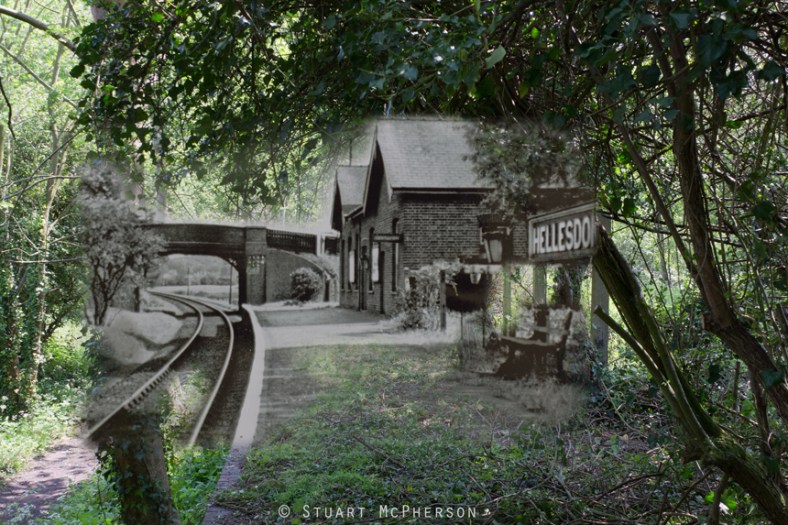
As I grew older I followed in my parents footsteps and started to use the old railway path as a means to spreading my young wings. My friends and I spent a lot of time cycling up and down the track to get to the River Tud, the Mill at Costessey and as far along as Drayton. We’d go swimming, fishing paddling or just exploring the countryside. I remember catching my first Chub in the river Tud near to the Red Bridge, jumping into the fast-flowing millrace at Costessey and admiring the spawning Barbel at the nearby sluice.
Every time I cycled through Hellesdon on an above-mentioned adventure, my mother’s words would echo in my head and I’d try to picture Hellesdon as a station. It was from here that the seed of interest she’d planted in my mind a few years back started to grow into the monster of an Oak it is now. The older I got the more interested I became, and when my friends and I were cycling around the old railway I’d secretly be on the lookout for clues that hinted to railway’s past. We didn’t have Google back then so the theories began to formulate in my head as to what I was looking at. I’d found the remains of another building down near Halfords and had convinced myself that what I was looking at was the platform for Norwich City Station. 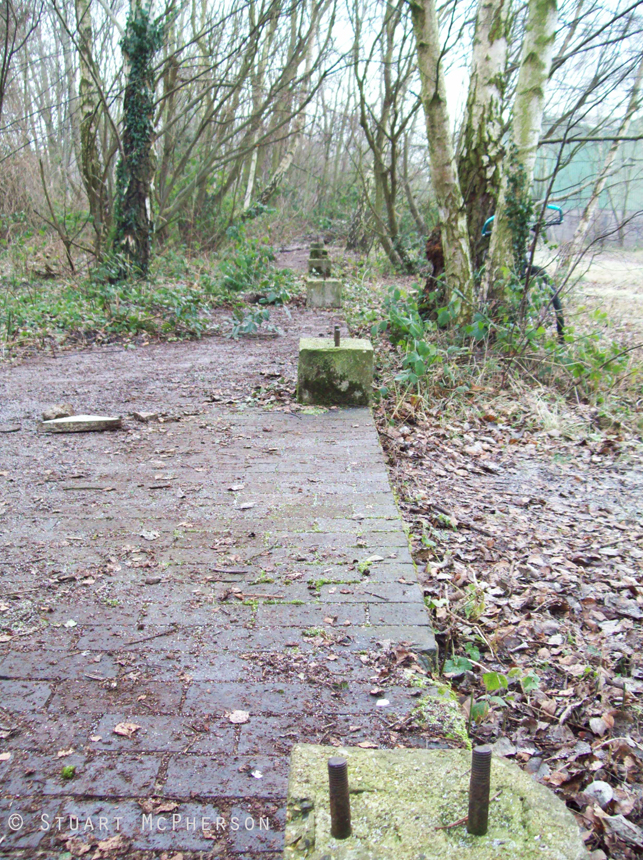
I was wrong of course, but there was know way of finding out proper. What I was actually looking at was the engine shed floor. I often used to think about pulling back the brambles to see what else I could find, but had I suggested it to my friends they would have most likely thought that I’d gone mad, and so I kept these ideas to myself.
Fast forward to about 2006. As an adult with a fairly well-paid job, I’d just started to rekindle my interest in photography (I used to have an old 35mm Praktica that was given to me by my dad and was subsequently stolen as I played arcade games in Yarmouth) and had started taking pictures of my surroundings, this in turn got me back into thinking about local history. I’d just moved into a new house off Drayton Road and the nearby river path led directly back out on to the Marriott’s Way – my old stomping grounds. I decided to retrace my footsteps and take another look at some of those items that had caught my attention as a child. Armed with a cheap digital camera and some vague memories I headed out in search of my childhood memories. Sure enough, the remains were exactly where I’d remembered and I started taking a few photographs. It was at this time that Photo sharing and the Internet were becoming popular, so I decided to start uploading my random images to an up and coming website named ‘Flickr‘. It was also at this time that I started to realise that the World Wide Web was also a great tool for researching History. This was my Eureka moment.
One of the best things I’d found online was access to old maps that could help me pinpoint what I was actually looking at in amongst those bushes and I started to verify what it was I was actually photographing. My Norwich City Station platform turned out to be the Engine shed and I’d soon found the remnants of Norwich City’s bay platform near to the edge of Halfords Car Park deep in some bushes littered with needles and empty cans of Super-strength Cider. The more I explored, the more I took pictures and uploaded them to Flickr. I never thought for one moment that anybody else would be out there looking at my images, or that anyone else would be as interested as I was as at what I was looking at. I was wrong.
Shortly after posting up my finds up on the Internet I came to be in contact with three gentlemen I’d never met before: Nick Stone, John Batley and a young lad named Daniel Knights. Little did I know at the time that these 3 strangers would become very good friends of mine some 10 years later!
During my infant googling, I stumbled across some pictures that John Batley had uploaded to another photo sharing site that he’d taken whilst exploring Marriotts Way. Some of his pictures really struck a chord with me, and they were photographs of the remains of Hellesdon Station; the source of my earlier childhood fascination. In amongst the bushes on top of the platform were the posts that held the Hellesdon Station name board and lamp-holders. I was gobsmacked to say the least. I contacted him by commenting on his pictures and we’d soon struck up a dialogue. We had so much in common, and although John was a little bit older than me, we were both Mile Cross Boys and were both fascinated by the remnants of the M&GN at City Station. John’s family were very much a railway family and his interest had stemmed from there. It turned out that John only lived about 150 yards away from me, a bit further North along Drayton Road.
Nick Stone and I met through Flickr, often commenting on each others’ work. We were both fascinated with local History and as it turned out also lived close to one another, only about 200 yards apart; either side of Wensum Park. Neither of us had any railway knowledge but were both interested in the history of it all. Nick had also spent a bit of his childhood growing up on the estate. What a small world. It was Nick’s idea to set up a Group on Facebook named ‘Norwich City Station Preservation Group/FONCS’ so that we could share and talk about pictures of the old Station Site and this is how the group now known as FONCS was born.
It was through FONCS that we also met a young lad named Daniel Knights who had a lot of knowledge for someone of his age. Dan was a true train spotter, the new breed of train spotter, (not the platform-loitering, number recording type!) and his enthusiasm for Railway Heritage was an inspiration to us all.
After many joint conversations via the FONCS Facebook page it was decided to meet face to face on site at City, and the rest as they say is now History. We became good friends and decided to meet up again. In the meantime I had taken it upon myself to clear the old platform wall at Hellesdon of Ivy and it looked fantastic: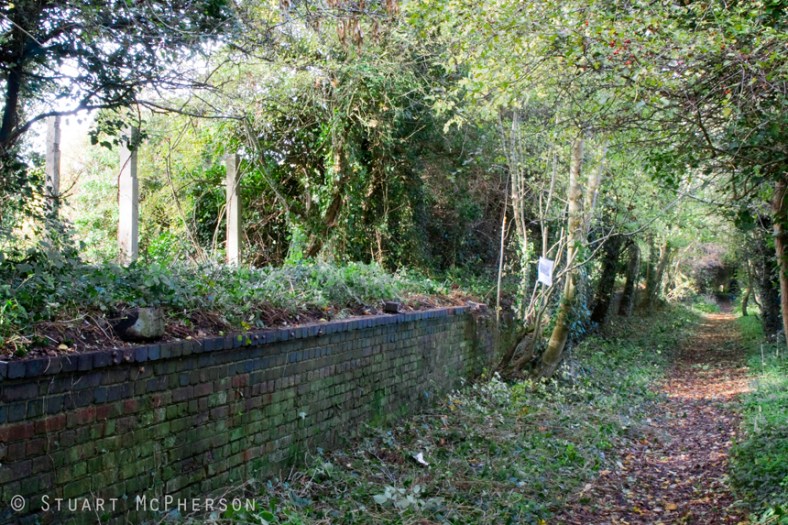 As the old platform emerged from undergrowth, the Vivtorian Brickwork came to life as it was exposed once again to the sunlight. My work at Hellesdon had the great knock-on effect of giving the rest of the group inspiration we needed. Out little meet-ups at City Station were beginning to attract more numbers and we decided to dig a few unofficial test pits to see if we could trace any more of the missing railway infrastructure. To our surprise, in one of our first digs we found what we believed to be the outer wall of Platform 1.
As the old platform emerged from undergrowth, the Vivtorian Brickwork came to life as it was exposed once again to the sunlight. My work at Hellesdon had the great knock-on effect of giving the rest of the group inspiration we needed. Out little meet-ups at City Station were beginning to attract more numbers and we decided to dig a few unofficial test pits to see if we could trace any more of the missing railway infrastructure. To our surprise, in one of our first digs we found what we believed to be the outer wall of Platform 1.
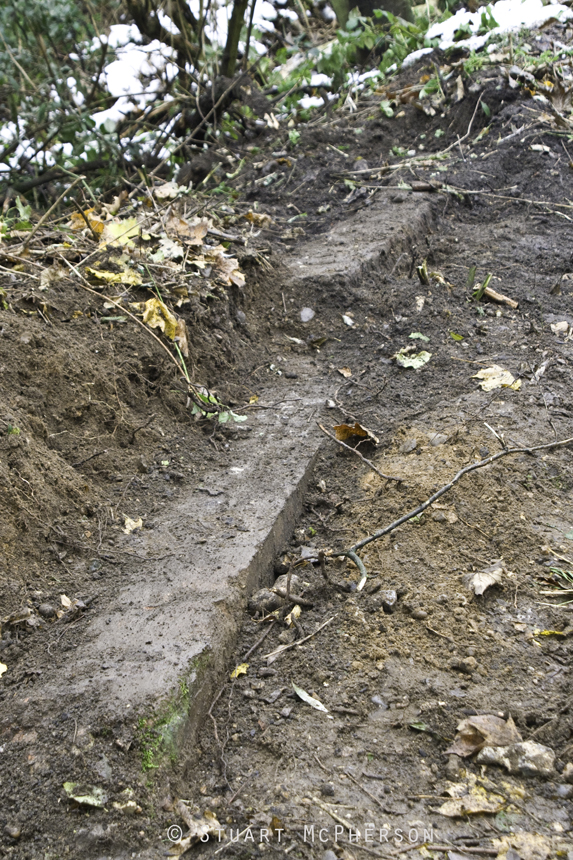
This was a big find and we thought it would be best to get in touch with Norwich City Council to see if they would give us the permission to dig further. Surprisingly, they agreed; although they were a bit unsure as to owned the land. They thought it belonged to British Rail and gave us the green light to dig as we pleased with the caveat that we might be asked to stop at any time should any body objected. We knew of course that BR had long ceased to exist, so we took our opportunity and decided to make Hay whilst the sun shone!
We got away with it for 3 whole years. We uncovered over 100 foot of the original Platform 1. This section had only managed to survive as it was hidden by the silt dredged from the nearby Wensum during the 1980’s. We used hand-tools and man power to cut back all the bushes, level the track-bed and rebuild and landscape Platform 1 to it’s original level.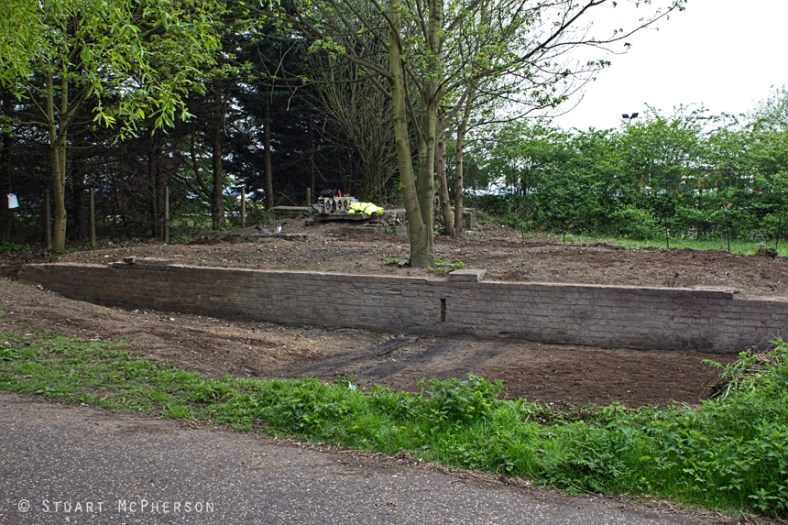
Our work was coming on well and it was all beginning to look rather fantastic. We’d tidied the area up, put a stop to the drug use and anti-social behaviour that had blighted the site previously and we’d often attract a crowd to watch us as we beavered away on a Saturday afternoon. It wasn’t long before we started to attract the attention the local press, starring on many pages of the EDP and Norwich Evening News. We also got an interview with Radio Norfolk’s Wally Webb. Unfortunately, the extra media coverage didn’t go unnoticed and somebody at Norfolk County Council must have done their homework. They finally cottoned on to the fact that it was actually their land – an asset. An asset that could cost them money, an asset that they were liable for, and an asset they could sell off to boost their limited coffers. Like everybody else, Norfolk County Council were (and still are) suffering with the effects of continuous Tory cutbacks and NPS are selling off bits and bobs all over the county. It turned out that they’d bought the disused railway for £1 back in the 1970’s with the single caveat that they had to maintain the bridges between City and Aylsham. It wasn’t long before they started demolishing railway infrastructure to make way for various road schemes and in an act of unwarranted corporate vandalism they also removed the fantastic A-Frame Bridge that stood where the Dragon Bridge now stands. They used the excuse that the bridge was too fatigued to be saved, but we now this not to be true. The bridge’s two remaining triplets live on to this day at Hellesdon and Drayton and were recently refurbished at a great cost by the Council. If you ask me it was money well-spent as they are fantastic examples of remaining Victorian architecture and ingenuity. It’s just a massive shame that they decided to remove the one by City Station.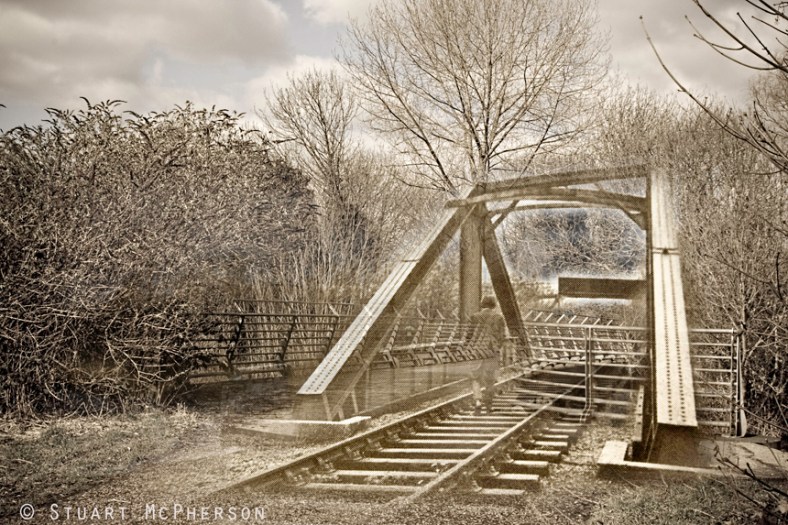
As soon as Norfolk County Council had cottoned on to the fact they owned the land, we were ordered to stop our excavations with immediate effect. Apparently the land was contaminated with asbestos and cyanide. Again, this wasn’t strictly true. Small traces of cyanide are a by-product of burnt coal and can be found on any old railway or in the fireplaces of most homes that use coal. The asbestos claim seemed more serious to us, but it turned out that a small piece of non-railway related asbestos was found by the Engine Shed far away from our excavations, probably dredged out of the river or left behind by a 1980’s fly-tipper. A specialist firm was brought in to tidy the Engine Shed floor, cap the pits with clay and remove any offending asbestos. When we spoke to the blokes working on site, they informed us that no asbestos had been found and the site was particularly clean considering its industrial past. I still believe to this day that this was a cynical ploy to stop us working on site and quick.
Shortly after these events had unfolded the NCC had the put the land, including the neighbouring ‘Train Wood’ up for sale. The local press were quick to report on the story (EDP article here) and we were quickly contacted by the local Green Councillors, nearby residents and concerned Marriott’s Way users all opposed to the plans to sell the land (and a section of Marriott’s Way) off.
A petition was put together that raised over 2,000 signatures in a short space of time and I personally handed it in to the full board at Norwich City Council. Why Norwich City Council? We knew that we would have no luck dealing with the County Council and decided to petition the City to get them to work with the County to come up with a better solution (EDP artcle here). The land was soon registered as an asset to the local community and we (FONCS) joined forces with the new group Friends of Train Wood to try and save this unique piece of history and its accompanying woodland.
The whole point of the petition managed to sail well over the blob-faced Tory Councillor, Cliff Jordan’s head and he was soon getting himself involved in another one of his many controversies by referring to us as ‘Dumb Nuts’, again reported by the EDP here. Shortly after, FONCS and FOTW were heavily involved in managing to help Norfolk County Council to secure a Heritage Lottery Fund bid to improve and promote the Railway Heritage of the site as reported by the Norfolk County Council’s own website here. I wonder if Cliff, who is now the leader of Norfolk County Council still considers us to be dumb nuts?
What about FONCS (and our expanded group the Norfolk Railway Heritage Group)? Well we are now considered by Norfolk County Council as the go-to people regarding Railway Heritage in Norwich and Norfolk. We have been assigned as experts to the recently-secured HLF bid and will be over-seeing the project to finish off what we started at Norwich almost 8 years ago. Work is set to recommence this September. I’ll be discussing it in my blog as it happens, so watch this space for further updates.
We will also be on site at City Station tomorrow (27th May 2017) along with the National Wildlife Trust to give guided heritage walks, show off old pictures, maps and books and discuss the site and its history with anybody interested. The first of our 3 ‘walk and talks’ starts at 11am. Please feel free to pop along and enjoy the occasion, it’s free and their will be a coffee/tea vendor and toilets on site.
We are also hard at work uncovering another abandoned railway station at Honing a bit further up the line from City and our progress can be followed on the Norfolk Railway Heritage Group Facebook page.
Thanks once again for reading this rather long blog post.
Stu
A great story of rediscovering our recent past, Stu. Your personal take brings home, more clearly, what’s gone. Reggie.
LikeLike
I used to live in Old Costessey in my teens and used this cycle path to get to the city centre many times a week and later on to get to work. It was an amazing journey I enjoyed every time. The section from Costessey through to Mile Cross, running behind the old Wickes store is a marvellous example of tranquil countryside in the middle of estates.
LikeLike